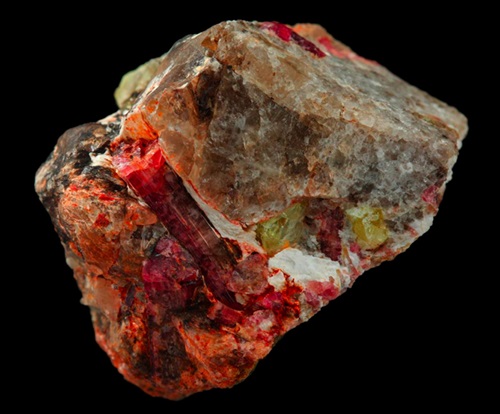Application of Rubidium in Geology: Rb-Sr Isotope System
May 28,2024
Natural rubidium consists of two isotopes, rubidium-85 (stable with 72.15% abundance) and rubidium-87 (27.85% abundance, a beta emitter with a half-life of 4.9 x 1010 years). Thus, geoscientists can use rubidium to determine the age of rocks and minerals, which called Rb-Sr dating method.

The Rb-Sr isotope system is highly useful due to the decay of 87Rb to 87Sr, which has a half-life of 49.23 billion years. Rb is a highly incompatible element and preferentially enters magmatic melts during partial mantle melting, rather than remaining in mantle minerals, leading to its enrichment in crustal rocks.
The radiogenic daughter isotope, 87Sr, is produced from this decay process and originated from stellar nucleosynthesis predating the solar system. Over time, different minerals in a geological setting acquire distinct ratios of radiogenic 87Sr to naturally occurring 86Sr (87Sr/86Sr). By measuring these ratios with a mass spectrometer, and knowing the initial 87Sr/86Sr ratio and the amount of 87Rb (determined from the present Rb content and the 85Rb/87Rb weight ratio), the age of these minerals can be calculated.
If minerals crystallize from the same silicic melt, they initially have identical 87Sr/86Sr ratios. However, because rubidium substitutes for K in minerals, and these minerals have different K/Ca ratios, their Rb/Sr ratios differ. During fractional crystallization, Sr tends to concentrate in plagioclase, leaving rubidium in the liquid phase. Consequently, the Rb/Sr ratio in the residual magma increases over time, leading to rocks with higher Rb/Sr ratios as differentiation progresses. Typically, Rb/Sr ratios increase in the sequence of plagioclase, hornblende, K-feldspar, biotite, and muscovite.
Given sufficient time for the production of radiogenic 87Sr, the measured 87Sr/86Sr values will differ among minerals, increasing in the same sequence. The age of a sample is determined by analyzing several minerals within multiple subsamples from different parts of the original specimen. The 87Sr/86Sr ratio for each subsample is plotted against its 87Rb/86Sr ratio on an isochron graph. If these points form a straight line, the subsamples are consistent, and the age determination is likely reliable. The slope of the line indicates the age of the sample.
Rb-Sr dating relies on accurately measuring the Rb-Sr ratio and deriving an accurate 87Sr/86Sr ratio for a mineral or whole rock sample. Before interpreting an Rb-Sr date as the time of emplacement or formation of a rock, several conditions must be met:
1. The system must have remained closed to rubidium and Sr diffusion since the rock formed or fell below the closure temperature (commonly 650℃).
2. The minerals used to construct the isochron must have formed in chemical equilibrium with each other, or in the case of sediments, been deposited simultaneously.
3. The rock must not have undergone metasomatism, which is the chemical alteration of a rock by hydrothermal and other fluids. This process can replace one rock with another of different mineralogical and chemical composition, potentially disturbing the Rb-Sr system.
One major disadvantage (and conversely, an important use) of using rubidium and Sr for radiometric dating is their relative mobility, especially in hydrothermal fluids. These alkaline elements are easily transported by the hot, often carbonated fluids present during metamorphism or magmatism. Such fluids may introduce new rubidium and Sr into the rock, altering its mineralogy and allowing Rb-Sr dating to determine the time of this alteration rather than the rock's initial formation. Therefore, to assign age significance to a result, it is necessary to carefully study the metasomatic and thermal history of the rock, any metamorphic events, and evidence of fluid movement. A Rb-Sr date that differs from other geochronometers may still be valuable, as it could provide data on another event rather than the formation age of the rock.
- Related articles
- Related Qustion
- What is the flame colour of rubidium? Jan 26, 2024
Rubidium is a soft, silvery-white metallic element of the alkali metals group (Group 1). It is one of the most electropositive and alkaline elements. Its flame is yellowish-violet.
- The Industrial Preparation of Rubidium Sep 26, 2019
Rubidium is a chemical element with the symbol Rb and atomic number 37. Rubidium is a very soft, silvery-white metal in the alkali metal group. Rubidium metal shares similarities to potassium metal and caesium metal in physical appearance,
- The applications of Rubidium Sep 26, 2019
Rubidium ,chemical symbol Rb, atomic number 37, and relative atomic mass (i.e., atomic weight) 85.4678(3), is the fourth alkali metal of group IA(1) of Mendeleev’s periodic chart. The word rubidium comes from the Latin rubidus, owing to the
Supplementation with pyridoxal 5'-phosphate monohydrate can synthesize neurotransmitters such as dopamine and serotonin, maintaining a healthy nervous system.....
Nov 4,2025Biochemical EngineeringAs the 74th most abundant element in Earth's crust, ruthenium is comparatively rare, this article will introduce its organic compounds.....
May 28,2024Inorganic chemistryRUBIDIUM
7440-17-7You may like






